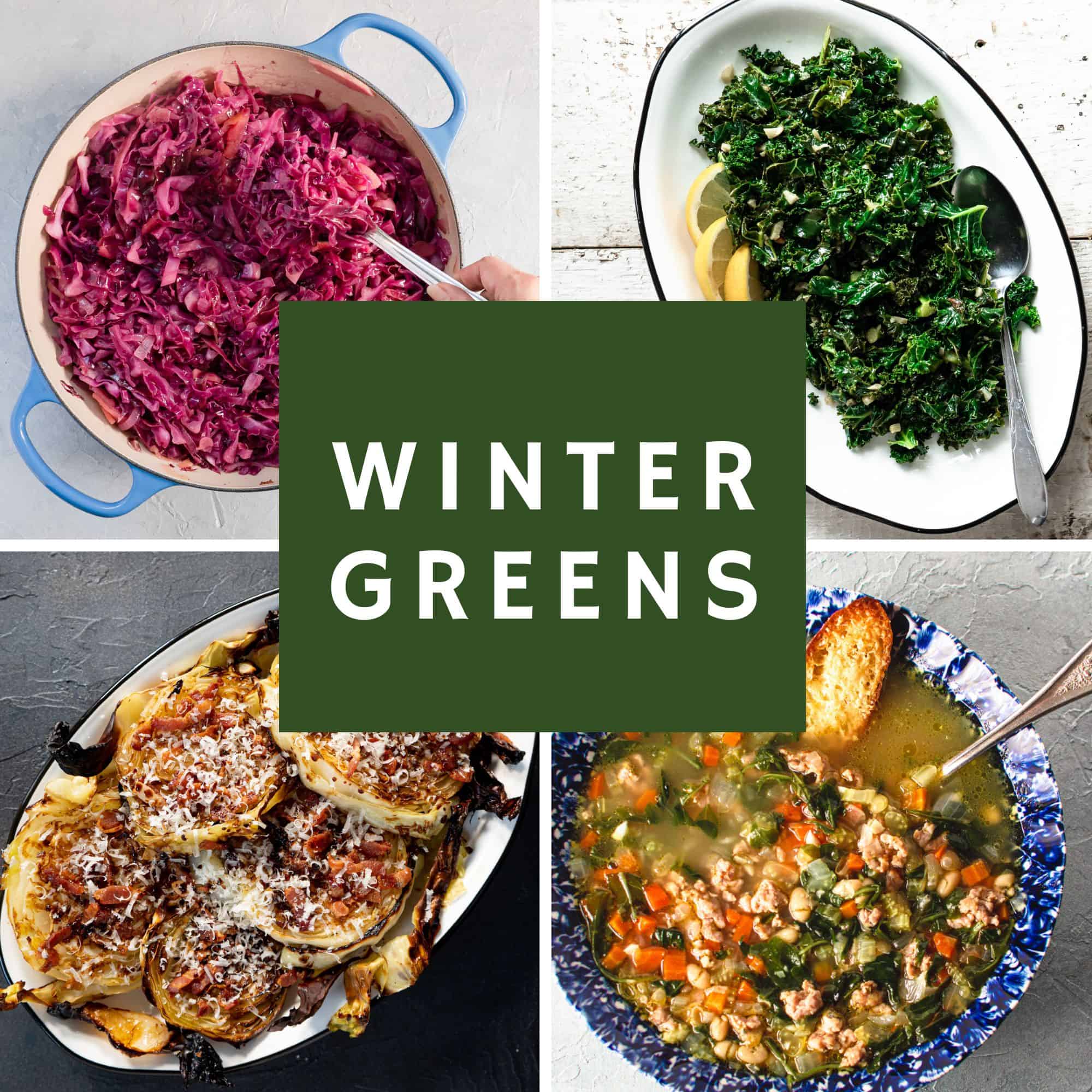Winter greens are a powerhouse of nutrition and flavor, making them an essential addition to any meal. As the temperatures drop and the days grow shorter, these hearty greens provide a burst of freshness and vitality to our plates. Whether you're looking to boost your immune system, support your heart health, or simply enjoy delicious seasonal fare, winter greens have got you covered.

They are called "winter greens" because they thrive in cooler weather conditions and are often harvested during the winter months when other crops may not be as readily available. This variety of winter green vegetables are hardy and resilient, able to withstand colder temperatures and even frost, which makes them perfect for growing in winter climates.
White Bean and Kale Soup, Cumin and Lime Coleslaw, and Arugula and White Bean salad are perfect examples of delicious recipes using Winter Greens.
Jump to:
Types of Winter Greens
Winter greens come in a variety of shapes, sizes, and flavors, each offering its own unique nutritional profile. Some popular varieties include:
- Kale: Known for its robust flavor and sturdy texture, kale is packed with vitamins A, C, and K, as well as calcium and iron. Try adding it into this nourishing Reset Soup as a variation to spinach.
- Spinach: With its tender leaves and mild taste, spinach is rich in iron, folate, and antioxidants.
- Swiss Chard: Featuring colorful stems and delicate leaves, Swiss chard is loaded with vitamins A, K, and C, along with magnesium and potassium.
- Collard Greens: These hearty greens have a slightly bitter taste and are high in vitamins A, C, and K, as well as calcium and fiber.
- Mustard Greens: Spicy and peppery, mustard greens are a good source of vitamins A, C, and K, as well as folate and calcium.
- Arugula: With its distinctive peppery flavor, arugula is rich in vitamins A and K, as well as calcium and magnesium.
- Cabbage: With its crisp texture and mild flavor, cabbage is rich in vitamins C and K, folate, potassium, and manganese, offering a versatile and nutritious addition to winter meals.
To learn more about the health benefits of winter greens continue reading this article by Healthline
How to Store Winter Greens
One of the other benefits of winter greens are their lasting power. If stored properly winter greens will keep for several days and even weeks!
How to store kale, collard greens, and Swiss chard
Wash and dry the leaves. Remove the tough stems from kale and collard greens. (stems of Swiss chard only need to be trimmed). Store the leaves in the crisper drawer in the fridge wrapped in paper towel and inside a plastic bag. Or store the leaves in a large airtight container lined with paper towel. They can last one week and sometimes longer.
How to freeze, wash, dry and prepare leaves and freeze in resealable bags for up to 6 months. You can freeze them whole or chopped.
How to Store Cabbage and Brussels Sprouts
Cabbage and Brussels sprouts are best stored whole. You can wash, dry and trim the ends of Brussels sprouts before storing either in a plastic bag or airtight container. I always toss in a piece of paper towel to absorb any moisture.
Cabbage doesn't need washing. Just peel off the outer layer of leaves and store in a plastic bag in the fridge. If you use only part of the cabbage wrap the cut piece tightly in plastic wrap and store in the fridge. Cabbage can last up to one month and Brussels sprouts for one week.
How to freeze - Cabbage can be frozen without blanching but will last much longer in the freezer after blanching. Cut cabbage into wedges and blanch in a large pot of boiling water for 4 minutes. Drain well and let cool and dry before freezing in resealable bags.
Brussels sprouts can be blanched and frozen whole. Blanch large ones for 5 minutes, 4 minutes for medium-size, and 3 minutes for small. Drain well and let dry before freezing in resealable bags. Freeze laying flat in one layer so you can easily pull out the amount that you want when ready to use.
How to Cook Winter Greens
Winter greens can be cooked in a variety of ways to bring out their natural flavors and textures. Here are some cooking tips and techniques to try:
- Quick blanching: Blanching winter greens in boiling water for a minute or two helps to soften their texture while preserving their nutrients and vibrant color.
- Sauteing: Saute winter greens with garlic and olive oil for a simple and flavorful side dish that pairs well with a wide range of main courses.
- Incorporating into soups and stews: Add chopped winter greens to soups, stews, and casseroles for an extra dose of nutrition and flavor.
- Adding to salads: Mix chopped winter greens with other salad ingredients for a fresh and healthy salad that's perfect for lunch or as a side dish.
- Blending into smoothies or juices: Sneak some winter greens into your morning smoothie or juice for a nutritious boost that's sure to start your day off right.
Winter Greens Recipes You Will Love












What to Serve With Winter Greens
Tried this recipe? I would love it if you could leave a star rating ⭐️⭐️⭐️⭐️⭐️ and/or a comment below. You can also follow me on social media here on Facebook, Instagram, and Pinterest!
Want to say thank you?









Comments
No Comments